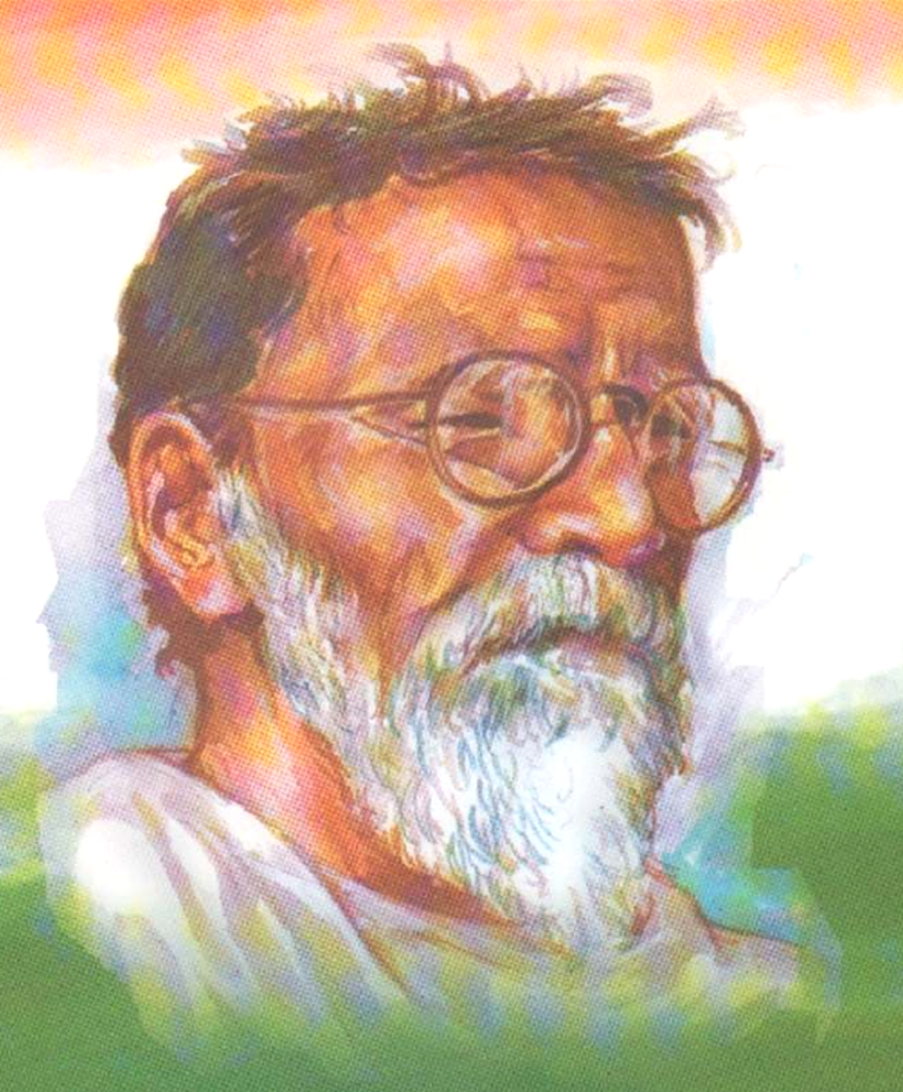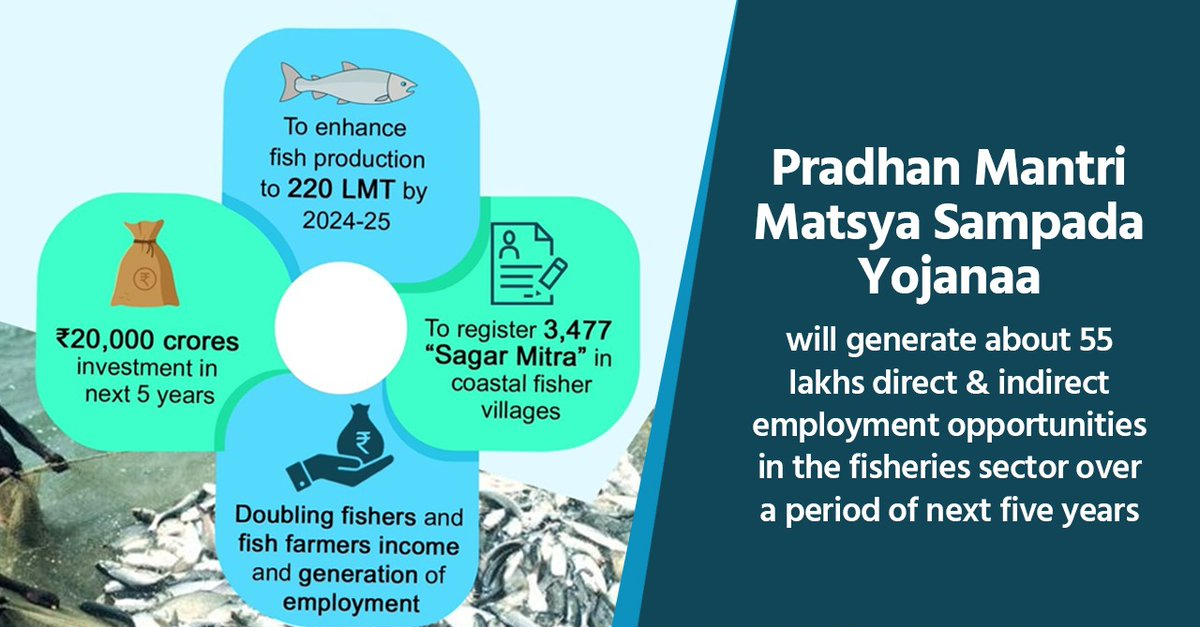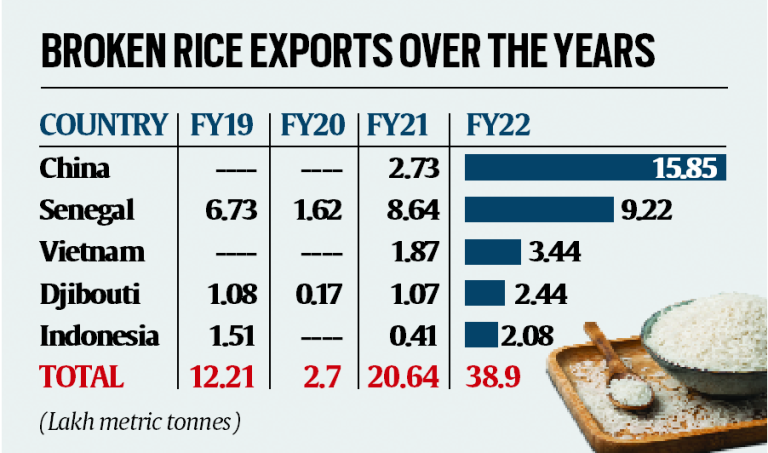Maps
Indian History
Acharya Vinoba Bhave
For Prelims: Important Personalities of Modern India
For Mains: Modern Indian History, Important Personalities, Freedom Struggle
Why in News?
Recently, the Prime Minister paid rich tributes to Acharya Vinoba Bhave on his birth Anniversary.
What do we need to know about Acharya Vinoba Bhave?
- Birth:
- Vinayak Narahari Bhave was born on 11th September 1895 in Gagode, Bombay Presidency (Maharashtra).
- He was the eldest son of Narahari Shambhu Rao and Rukmini Devi.
- Brief Profile:
- Acharya Vinoba Bhave was a nonviolence activist, freedom activist, social reformer and spiritual teacher.
- Being an avid follower of Mahatma Gandhi, Vinoba upheld his doctrines of non-violence and equality.
- He dedicated his life to serve the poor and the downtrodden, and stood up for their rights.
- Awards & Recognition:
- Vinoba was the first recipient of the international Ramon Magsaysay Award for Community Leadership in 1958.
- He was also conferred with the Bharat Ratna (India's highest civilian awards) posthumously in 1983.
- Association with Gandhi:
- Vinoba met Gandhi on 7th June 1916 and took residence at the Ashram.
- Gandhi’s teachings led Bhave to a life of austerity dedicated to improving Indian village life.
- The name Vinoba (a traditional Marathi epithet signifying great respect) was conferred upon him by Mama Phadke, another member of the Ashram.
- On 8th April 1921, Vinoba went to Wardha to take charge of a Gandhi-ashram there under the directives from Gandhi.
- During his stay at Wardha, Bhave also brought out a monthly in Marathi, named, `Maharashtra Dharma' which consisted of his essays on the Upanishads.
- Vinoba met Gandhi on 7th June 1916 and took residence at the Ashram.
- Role in Freedom Struggle:
- He took part in programs of non-cooperation and especially the call for use of Swadeshi goods instead of foreign imports.
- He took up the spinning wheel churning out Khadi and urged others to do so, resulting in mass production of the fabric.
- In 1932, Vinoba was sent to jail for six months to Dhulia as he was accused of conspiracy against British rule.
- During the imprisonment, he explained to fellow prisoners the different subjects of 'Bhagwad Gita', in Marathi.
- All the lectures given by him on Gita in Dhulia jail were collected and later published as a book.
- He was also chosen as the first Individual Satyagrahi (an Individual standing up for Truth instead of a collective action) by Gandhi himself.
- He served a five-year prison sentence in the 1940s for leading nonviolent resistance to British rule.
- He was given the honorific title “Acharya” (teacher).
- Role in Social Work:
- He worked tirelessly towards eradicating social evils like inequality.
- Influenced by the examples set by Gandhi, he took up the cause of people who were referred to as Harijans by Gandhi.
- He adopted the term Sarvodaya from Gandhi which simply means “Progress for All”.
- The Sarvodaya movement under him implemented various programs during the 1950s, the chief among which is the Bhoodan Movement.
- Bhoodan Movement:
- In 1951, Vinoba Bhave started his peace-trek on foot through the violence-torn region of Telangana.
- On 19th 1951, the Harijans of the Pochampalli village requested him to provide them with around 80 acres of land to make a living.
- Vinoba asked the landlords of the village to come forward and save the Harijans.
- A landlord got up and offered the required land.
- It was the beginning of the Bhoodan (Gift of the Land) movement.
- The movement continued for thirteen years and Vinoba toured the length and breadth of the country, a total distance of 58741 Km.
- He was successful in collecting around 4.4 million acres of land, of which around 1.3 million was distributed among poor landless farmers.
- The movement attracted admiration from all over the world and was commended for being the only experiment of his kind to incite voluntary social justice.
- Religious Work:
- He set up a number of Ashrams to promote a simple way of life, devoid of luxuries that took away one’s focus from the Divine.
- He established the Brahma Vidya Mandir in 1959, a small community for women, aiming at self-sufficiency on the lines of Mahatma Gandhi’s teachings.
- He took a strong stand on cow slaughter and declared to go on fast until it was banned in India.
- Literary Work:
- His important books include: Swarajya Sastra, Geeta Pravachane, Teesri Shakti or The Third Power etc.
- Death:
- Died in 1982, Wardha, Maharashtra.


Governance
Pradhan Mantri Matsya Sampada Yojana (PMMSY)
For Prelims: Pradhan Mantri Matsya Sampada Yojana (PMMSY), Atmanirbhar Bharat, Kisan Credit Card
For Mains: Government Initiatives for the Promotion of Rural Economy, Pradhan Mantri Matsya Sampada Yojana (PMMSY), its Achievements, Significance and Way Forward
Why in News?
Recently, the second Anniversary of Pradhan Mantri Matsya Sampada Yojana (PMMSY) was celebrated.
- PMMSY envisages generation of 68 lakh Employment by the end of 2024-25.
What is PMSSY?
- About:
- PMMSY was introduced by the Government of India, as part of the ‘Atma Nirbhar Bharat’ package with the investment of Rs. 20,050 crores, the highest ever investment in the Fishery sector.
- Fishermen are provided with insurance cover, financial assistance and a facility of Kisan Credit Card as well.
- Aim and Objectives:
- PMMSY aims towards the purpose of rural development by utilizing rural resources and boosting rural economy in a rapid way.
- The main motto of PMMSY is ‘Reform, Perform and Transform’ in the fisheries sector.
- The reforms and initiatives in PMMSY scheme have been inculcated in:
- Core & trunk infrastructure development
- Modernization of Indian fisheries by undertaking the efforts such as:
- Push for new fishing harbours/landing centres
- Modernisation and mechanization of traditional fishermen crafts-trawlers-deep sea going vessels
- Provision of post-harvest facilities to reduce post-harvest loss
- Cold chains facilities
- Clean and hygienic fish markets
- Two wheelers with ice boxes
- Achievements:
- Fisheries sector showed impressive growth of 14.3% from 2019-20 to 2021-22.
- Fish production reached an all-time high of 141.64 lakh tons during 2019-20 to 161.87 lakh tons during 2021-22.
- Fisheries sector saws all-time high exports of 13.64 lakh tonnes valuing Rs 57,587 crore dominated by exports of shrimps.
- Currently, exports to 123 countries are taking place including China, Thailand, Japan, Taiwan, Tunisia, the United States, Hong Kong, Kuwait, etc.
- PMMSY has supported 31.47 lakh farmers under insurance coverage from 22 states and 7 UTs.
- Fisheries sector showed impressive growth of 14.3% from 2019-20 to 2021-22.
- Implementation:
- It is implemented as an umbrella scheme with two separate components namely:
- Central Sector Scheme: The project cost will be borne by the Central government.
- Centrally Sponsored Scheme: All the sub-components/activities will be implemented by the States/UTs and the cost will be shared between the Centre and State.
- It is implemented as an umbrella scheme with two separate components namely:
- Forthcoming Plan:
- Aquaculture promotion will be undertaken especially in the saline and alkaline areas of Northern India.
- Also, focus will be laid on Aquatic health management involving the address of diseases, antibiotic and residue issues which will be supported by an integrated laboratory network.
- Way Forward:
- Fishery and fish farmers comprise the nucleus of PMMSY. The true potential of our reservoirs and natural resources can be utilized by infusion of technology and public stocking and rejuvenation of water bodies by river and sea ranching programme.
- Scientific practices must be adopted in fish farming for bringing India to the top of the global map in terms of productivity.

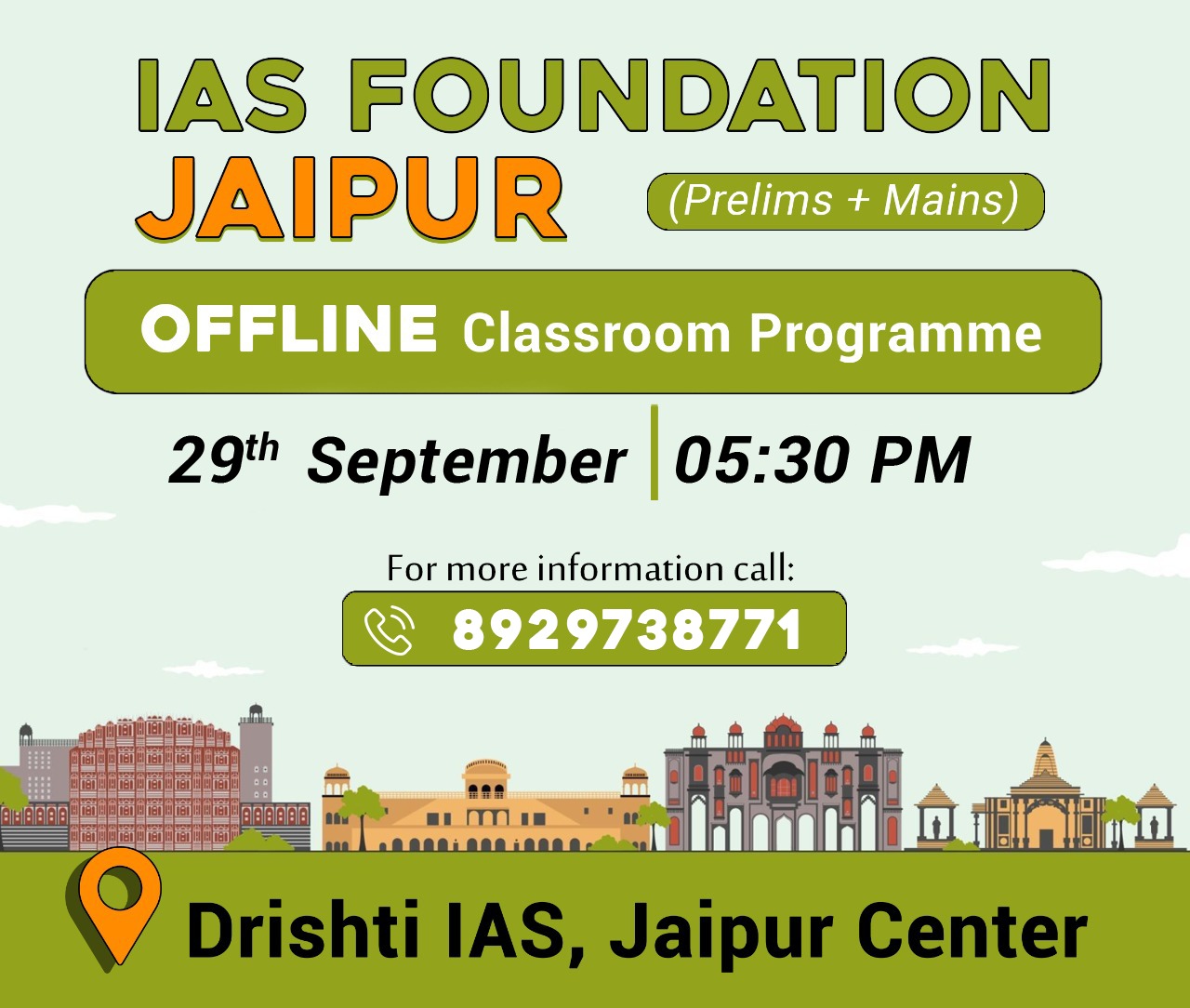
Indian Economy
Ban on Exports of Broken Rice
For Prelims: Broken rice, Export Ban
For Mains: Government Policies & Interventions, Food Security
Why in News?
Recently, India has banned exports of broken rice and imposed a 20% duty on exports of non-Basmati rice except for parboiled rice to boost domestic supplies amid a fall in area under the paddy crop in the current Kharif season.
- India is the world's biggest exporter of rice which accounts for more than 40% of global rice shipments and it competes with Thailand, Vietnam, Pakistan, and Myanmar in the world market.
What is the Significance of Broken Rice?
- It is often used in the manufacture of feed for very young animals and for pets. Further, it is used for all types of livestock and is particularly suitable due to its rich caloric value and low fibre content.
- It is also used in the brewing industry, where it is mixed with barley and the production of arak (aniseed alcoholic drink, distilled, colourless drink).
- It is a raw material for rice flour, used in baby food, breakfast cereals, rice wine, rice liqueur, sake, and prepackaged and canned foods.
Why did the Government Ban the Export?
- Unusual rise in Exports: The broken rice exports have increased 42 times to 21.31 lakh metric tonnes (LMT) during April-August 2022 as compared to 0.51 LMT during the corresponding period of 2019.
- China was the top buyer (15.85 LMT) of Indian broken rice in 2021-22.
- Paucity in Domestic Market: Broken rice is also not available either for poultry feed or for ethanol for which they were using broken rice or damaged foodgrains.
- Rise in Global Demand: There has been a rise in global demand for broken rice due to a geo-political scenario which has impacted price movement of commodities.
- Decline in Domestic Production: The likely shortfall in area and production of Paddy for the Kharif season 2022 is 6% approx.
- The total rice sowing during the current kharif season has been so far about 20 lakh hectares less as compared to the corresponding figure of the last year due to poor rains in some states.
- Rice production may fall by 10 million tonnes and in the worst case it can be 12 million tonnes.
UPSC Civil Services Examination Previous Year Question (PYQ)
Prelims
Q. According to India’s National Policy on Biofuels, which of the following can be used as raw materials for the production of biofuels? (2020)
- Cassava
- Damaged wheat grains
- Groundnut seeds
- Horse gram
- Rotten potatoes
- Sugar beet
Select the correct answer using the code given below:
(a) 1, 2, 5 and 6 only
(b) 1, 3, 4 and 6 only
(c) 2, 3, 4 and 5 only
(d) 1, 2, 3, 4, 5 and 6
Ans: (a)
Exp:
- The National Policy on Biofuels, 2018, allows production of ethanol from damaged food grains like wheat, broken rice, etc., which are unfit for human consumption.
- The Policy also allows conversion of surplus quantities of food grains to ethanol, based on the approval of the National Biofuel Coordination Committee.
- The Policy expands the scope of raw material for ethanol production by allowing use of sugarcane juice, sugar containing materials like sugar beet, sweet sorghum, starch containing materials like corn, cassava, damaged food grains like wheat, broken rice, rotten potatoes, unfit for human consumption for ethanol production. Hence, 1, 2, 5 and 6 are correct. Therefore, option (a) is the correct answer

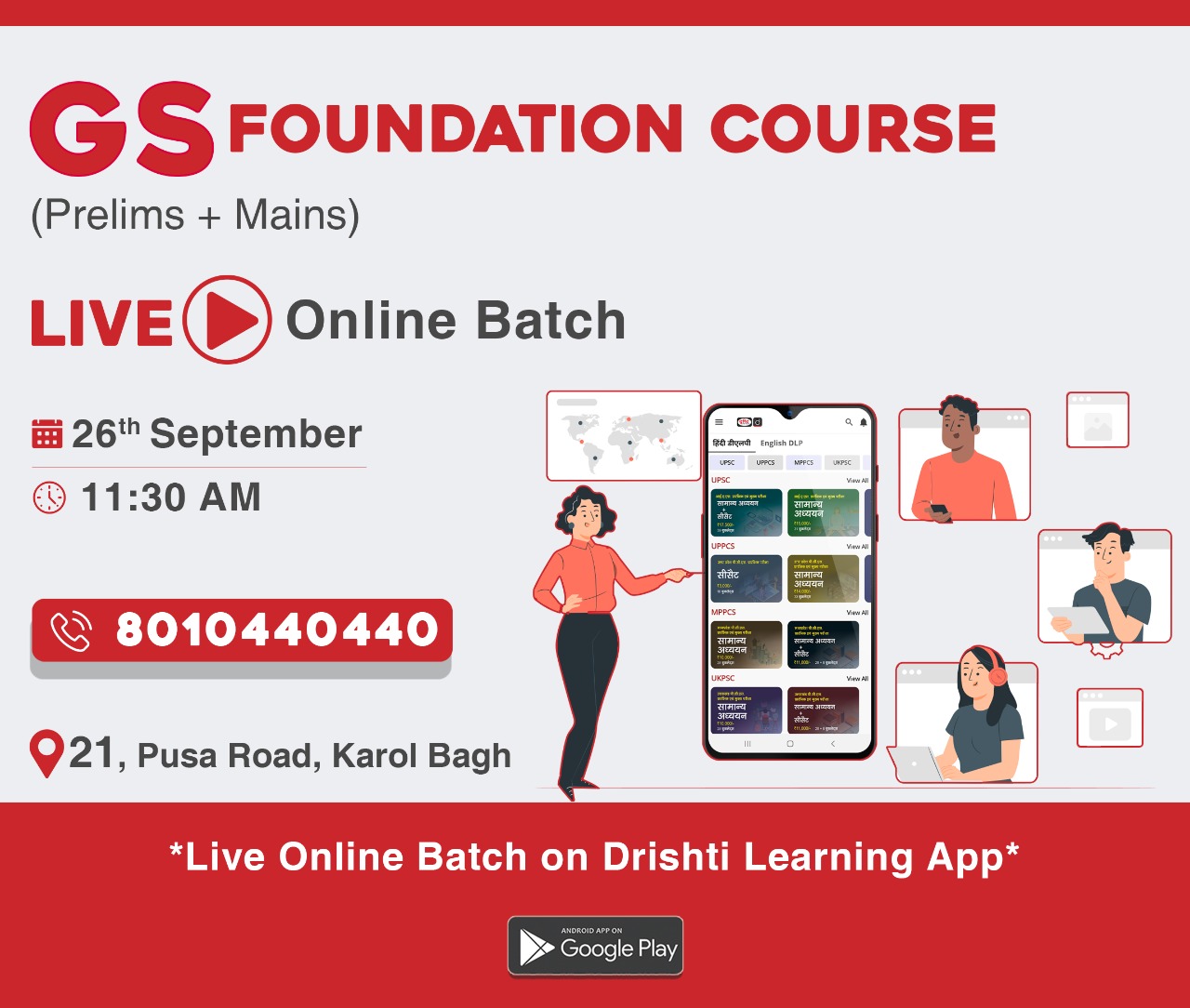
International Relations
Indo-Pacific Economic Framework
For Prelims: Indo-Pacific, Quad, CEPA (Comprehensive Economic Partnership Agreements)
For Mains: Groupings & Agreements Involving India and/or Affecting India's Interests, Bilateral Groupings & Agreements, QUAD, Indo-Pacific and its Significance
Why in News?
Recently, the Minister of Commerce & Industry addressed the Indo-Pacific Economic Framework (IPEF) Ministerial meeting in the US, where India decided to stay away from the Fair & resilient trade Pillar.
- India agreed to three out of four pillars, which are Supply Chains, Tax & Anti-Corruption and Clean Energy.
What is IPEF?
- It is a US-led initiative that aims to strengthen economic partnership among participating countries to enhance resilience, sustainability, inclusiveness, economic growth, fairness, and competitiveness in the Indo-Pacific region.
- The IPEF was launched in 2021 with a dozen initial partners who together represent 40% of the world GDP.
- The IPEF is not a Free Trade Agreement (FTA) but allows members to negotiate the parts they want to. The negotiations will be along four main “pillars”.
- Supply-chain resilience
- Clean energy, decarbonisation & infrastructure
- Taxation & anti-corruption
- Fair & resilient trade.
- Currently, India and 13 countries located in the Pacific Ocean are its members,
- Australia, Brunei, Fiji, India, Indonesia, Japan, South Korea, Malaysia, New Zealand, Philippines, Singapore, Thailand, United States, and Vietnam.
What is India’s position on the IPEF?
- While some countries had expressed interest in joining negotiations, India did not declare a definitive position for some time because it will be watching what benefits member countries will derive and whether any conditionalities on aspects like environment may discriminate against developing countries.
- Some areas proposed in the IPEF do not appear to serve India’s interests.
- For example, the IPEF talks about digital governance but the IPEF formulation contains issues that directly conflict with India’s stated position.
- India is in the process of firming up its own digital framework and laws, particularly regarding privacy and data, and it would wait for more information.
- In August 2022, the Indian government withdrew the Personal Data Protection Bill from Parliament, saying it would consider “comprehensive legal framework” to regulate the overall Internet ecosystem, cybersecurity, etc.
- The US has earlier expressed concerns about the possibility of the Indian side demanding data localisation or the storage and processing of Indian users’ data in servers located in India and not the US, even in the case of data of US-based companies.
- A US report expressed that India’s policy will serve as significant barriers to digital trade and act as market access barriers, especially for smaller firms.
How is IPEF Different from Other Trade Deals?
- The IPEF is not exactly a trade pact and the provision of multiple pillars does entail an option for participants to choose what they want to be a part of.
- It’s not a take-it-or-leave-it arrangement, like most multilateral trade deals are.
- Since the IPEF is not a regular trade pact, the members so far are not obligated by all the four pillars despite being signatories.
- So, while staying off the trade part of the arrangement, India has joined the other three pillars of the multilateral arrangement – supply chains, tax and anti-corruption and clean energy.
What is India's Vision for the Indo-Pacific Region?
- India’s trade in this region is growing rapidly, with overseas investments being directed towards the East, e.g., the Comprehensive Economic Partnership Agreements with Japan, South Korea, and Singapore, and the Free Trade Agreements with ASEAN (Association of Southeast Asian Nations) and Thailand.
- India has been active in championing a Free and Open Indo-Pacific. The US, Australia, and the members of the ASEAN have all expressed a common view that India plays a greater role in the region.
- India, along with its Quad partners, is improving its game in the Indo-Pacific.
- India’s view is to work with other like-minded countries in the Indo-Pacific region to cooperatively manage a rules-based multipolar regional order and prevent any single power from dominating the region or its waterways.
UPSC Civil Services Examination Previous Year Question (PYQ)
Q. The new tri-nation partnership AUKUS is aimed at countering China’s ambitions in the Indo-Pacific region. Is it going to supersede the existing partnerships in the region? Discuss the strength and impact of AUKUS in the present scenario. (2021)

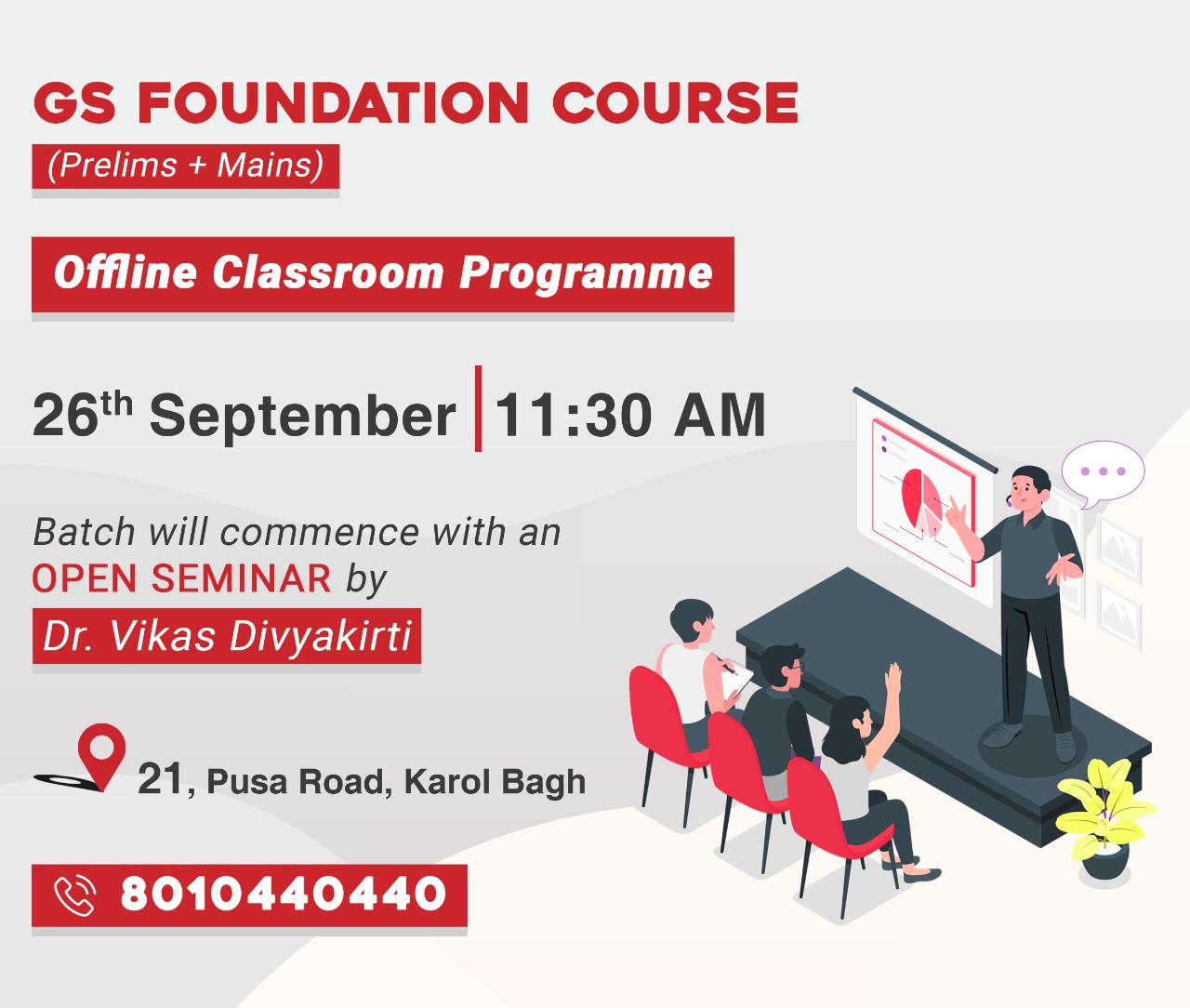
Ethics
Crack Down on Illegal Liquor Supply
For Mains: Dimensions of Ethics, Determinants and Consequences of Ethics in Human Action
Why in News?
Recently, an Indian Police Service (IPS) officer used soft policing to crack down on illegal hooch distilleries in Solapur (Maharashtra).
- Hooch is made when ‘country alcohol’ or cheap distilled liquor (desi daru) is adulterated with industrial alcohol or methanol to increase its intoxicating potency.
- National Crime Records Bureau (NCRB) data show that 6,172 people died between 2016 and 2020 due to the consumption of illicit hooch in India
What are the Responsibilities of Different Stakeholders involved in Such Operations?
- State and Central Governments:
- Implement the constitutional values by endeavouring for prohibition (Article 47).
- Maintain impartiality in taking legal actions against the culprits.
- Be transparent and uphold rule of law in investigations.
- Maintain fairness in decision making and determining the accountability of mishaps.
- District Magistrate:
- Maintaining nonpartisanship and probity in bringing perpetrators to justice no matter how powerful they might be.
- Show empathy towards the victims and their families.
- Police:
- Curb the illegal liquor trade with an unbiased attitude
- To maintain nonpartisanship in discharge of their duty by not sidelining or exonerating the politicians.
- Maintaining integrity while delivering duty.
- Be accountable for its omissions and commissions.
- Rectitude of dereliction duties.
- Elimination of corruption, promoting honesty in discharge of duties.
- Media:
- Be responsible and liable for their reports.
- Being one of the pillars of democracy it is their duty to report the truth fearlessly but objectively.
- Ministers/ MLAs:
- Uphold integrity by following the laws in letter and spirit.
- Pay allegiance to the oath of public service
- Society:
- Inculcate moral restraint to abjure consumption of liquor, which also causes health hazards.
- Embracing the Gandhian ideals of prohibition.
- Perform the duty of being a good citizen by helping the administration and police to bring about justice.
What should be the Way Forward?
- Soft Policing Method:
- ‘Operation Parivartan’, a four-point action plan that combined soft policing methods such as counselling with a concerted crackdown on the haath bhattis or the hand-operated illicit liquor distilleries in the police district was launched.
- Public Campaign Strategy:
- Start a public campaign with advertisements, street plays etc. to appeal to people to avoid the consumption of liquor.
- Rehabilitation Process:
- Facilitate rehabilitation process of people addicted to alcohol, for this, allocation of adequate funds from the Government to open deaddiction centres for the same.


Biodiversity & Environment
Hydrogen Fuel Cell
For Prelims: Hydrogen fuel cells, Green hydrogen, Brown hydrogen, Grey hydrogen, Blue hydrogen, National Hydrogen Energy Mission (NHM).
For Mains: Significance of Hydrogen Fuel Cell.
Why in News?
Recently, Germany launched the world’s first fleet of fully hydrogen-powered trains, these are emissions-free trains that can reach speeds of 140 kilometres per hour and can run about 1,000 km before the tank runs dry.
What are the Key Points of Hydrogen Fuel Cell?
- About:
- Hydrogen fuel cells are a clean, reliable, quiet, and efficient source of high-quality electric power.
- They use hydrogen as a fuel to drive an electrochemical process that produces electricity, with water and heat as the only by-products.
- Hydrogen is one of the most abundant elements on earth for a cleaner alternative fuel option.
What are the Types of Hydrogen based on the process of its formation?
- Green hydrogen is produced by electrolysis of water using renewable energy (like Solar, Wind) and has a lower carbon footprint.
- Electricity splits water into hydrogen and oxygen.
- By Products: Water, Water Vapor.
- Brown hydrogen is produced using coal where the emissions are released into the air.
- Grey hydrogen is produced from natural gas where the associated emissions are released into the air.
- Blue hydrogen is produced from natural gas, where the emissions are captured using carbon capture and storage.
- Significance:
- Best Zero Emission Solutions: It is one of the best Zero Emission solutions. It is completely environment friendly with no tailpipe emissions other than water.
- Tailpipe emissions: Emission of something such as gas or radiation into the atmosphere.
- Quiet operation: The fact that the fuel cells make little noise means that they can be used in challenging contexts, such as in hospital buildings.
- Easier scaling: Operation times of fuel cells are longer than those of batteries, with fuel cells, only the amount of fuel needs to be doubled to double the operation time, while batteries require the capacity of the components to be doubled to achieve the same.
- Best Zero Emission Solutions: It is one of the best Zero Emission solutions. It is completely environment friendly with no tailpipe emissions other than water.
- Issues:
- High Cost: Green hydrogen makes up only 0.03% of global hydrogen production and it is up to five times more expensive than ‘grey’ hydrogen produced from natural gas or worse, ‘brown’ hydrogen produced from coal.
- Hydrogen Storage: Storage and transportation of hydrogen is more complex than that required for fossil fuels. This implies additional costs to consider for hydrogen fuel cells as a source of energy.
- Hydrogen Extraction: Despite being the most abundant element in the Universe, hydrogen does not exist on its own so needs to be extracted from water via electrolysis or separated from carbon fossil fuels.
- Both of these processes require a significant amount of energy to achieve. This energy can be more than that gained from the hydrogen itself as well as being expensive.
- In addition, this extraction typically requires the use of fossil fuels, which in the absence of carbon capture and storage (CCS) undermines the green credentials of hydrogen.
- Indian Scenario:
- Initiatives Taken: The Union Budget for 2021-22 has announced a National Hydrogen Energy Mission (NHM) that will draw up a road map for using hydrogen as an energy source.
- Other Initiatives for Renewable Energy:
- There is a potential for India to save more than 24 million tonnes of CO2 emissions every year and 2,400 million litres of diesel fuel (and associated costs) if the trains are switched to hydrogen.
- India currently has around 13,500 trains running every day, around 5,000 (37%) of these are diesel locomotives and the rest is fully electrified.
Way Forward
- Emission Friendly Alternatives: Another alternative that many hydrogen councils across the world are pushing for is ‘blue’ hydrogen, which is grey hydrogen coupled with additional installations for carbon capture and storage incorporated into the production facility.
- This way, up to 90% of the CO2 emitted during hydrogen production can be captured for reuse or storage and prevented from escaping into the atmosphere.
UPSC Civil Services Examination Previous Year Question (PYQ)
Prelims
Q. Hydrogen fuel cell vehicles produce one of the following as “exhaust” (2010)
(a) NH3
(b) CH4
(c) H2O
(d) H2O2
Ans: (c)
Exp:
- A fuel cell is a device that converts chemical energy (energy stored in molecular bonds) into electrical energy.
- It uses Hydrogen gas (H2) and Oxygen gas (O2) as fuel and the products of the reaction in the cell are water (H2O), electricity, and heat.
- This is a big improvement over internal combustion engines, coal-burning power plants, and nuclear power plants, all of which produce harmful byproducts. Therefore, option (c) is the correct answer


Social Justice
Operation ‘Gear Box’
For Prelims: Operation ‘Gear Box’
For Mains: Problem of drug abuse and related Initiatives
Why in News?
Recently, the Directorate of Revenue Intelligence (DRI) launched operation ‘Gear Box’ to stop heroin smuggling, seizes 39.5 kg of contraband from Kolkata port.
- The heroin was examined and seized under provisions of the Narcotic Drugs and Psychotropic Substances Act.
What is Operation Gear Box?
- Operation Gear Box is conducted to detect the hidden drugs in the gear boxes.
- The gears from old and used gearboxes were removed after opening them and plastic packets containing the narcotic substance were placed in the created cavity and the gearboxes were refitted to avoid detection.
- The drug syndicate has used this unique modus operandi to conceal heroin.
- These packets were shipped concealing inside this metal scrap with other metal scrap so that it would go unnoticed by the authorities.
What about Drug Addiction in India?
- The menace of drug addiction has spread fast among the youth of India.
- India is sandwiched between two largest Opium producing regions of the world that is the Golden triangle on one side and the Golden crescent on other.
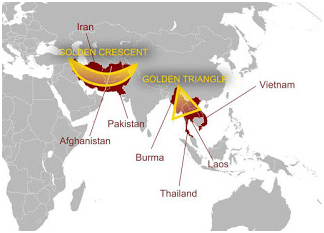
- The golden triangle area comprises Thailand, Myanmar, Vietnam and Laos.
- The golden crescent area includes Pakistan, Afghanistan and Iran.
- India is sandwiched between two largest Opium producing regions of the world that is the Golden triangle on one side and the Golden crescent on other.
- According to the World Drug Report 2022, India is one of the world's single largest opiate markets in terms of users and would likely be vulnerable to increased supply.
- According to the National Crime Records Bureau’s Crime in India 2020 report, a total of 59,806 cases were lodged under NDPS Act.
- According to the Social Justice Ministry and All India Institute of Medical Sciences (AIIMS) report on magnitude of substance use in 2019, there were:
- 3.1 crore cannabis users (of which 25 lakhs were dependent users).
- 2.3 crore opioid users (of which 28 lakhs were dependent users).
What are the Other Related Initiatives?
What are the International Treaties and Conventions to Combat Drug Menace?
- India is signatory of the following International treaties and conventions to combat the menace of Drug Abuse:
- United Nations (UN) Convention on Narcotic Drugs (1961)
- UN Convention on Psychotropic Substances (1971)
- UN Convention against Illicit Traffic in Narcotic Drugs and Psychotropic Substances (1988)
- UN Convention against Transnational Organized Crime (UNTOC) 2000.
UPSC Civil Services Examination Previous Year Question (PYQ)
Q. India’s proximity to the two of the world’s biggest illicit opium-growing states has enhanced her internal security concerns. Explain the linkages between drug trafficking and other illicit activities such as gunrunning, money laundering and human trafficking. What counter-measures should be taken to prevent the same? (2018)


Important Facts For Prelims
Serious Fraud Investigation Office
Why in News?
The Serious Frauds Investigation Office (SFIO) has arrested the alleged mastermind of a widespread racket involving the setting up of shell companies with Chinese links and supply of dummy directors.
- SFIO was assigned by the government to investigate Jillian Consultants India Pvt Ltd and 32 other companies.
What are the Shell Companies?
- A shell company is a firm that does not conduct any operations in the economy, but it is formally registered, incorporated, or legally organized in the economy.
- These are sometimes used illegitimately, such as to disguise business ownership from law enforcement or the public.
What is SFIO?
- About:
- SFIO is a multi-disciplinary organization under the Ministry of Corporate Affairs, consisting of experts in the field of accountancy, forensic auditing, law, information technology, investigation, company law, capital market and taxation for detecting and prosecuting or recommending for prosecution white-collar crimes/frauds.
- It has its head office in New Delhi.
- The Computer Forensic and Data Mining Laboratory (CFDML) was set up in 2013 to provide support and service to the officers of SFIO in their investigations.
- SFIO is headed by a Director as Head of Department in the rank of Joint Secretary to the Government of India.
- Serious Fraud investigation (SFIO) was initially set up by the Government of India by way of a resolution dated 2nd July, 2003. At that time SFIO did not enjoy a formal legal status.
- SFIO is a multi-disciplinary organization under the Ministry of Corporate Affairs, consisting of experts in the field of accountancy, forensic auditing, law, information technology, investigation, company law, capital market and taxation for detecting and prosecuting or recommending for prosecution white-collar crimes/frauds.
- Function and Roles:
- Section 211 of the Companies Act, 2013, has accorded statutory status to the Serious Fraud Investigation Office (SFIO).
- SFIO also has powers to arrest people for the violation of the Company law.
- An investigation into the affairs of a company can be initiated by the Central Government and entrusted to the Serious Fraud Investigation Office under the following circumstances:
- On receipt of a report of the Registrar or inspector under section 208 (Report on Inspection made) of the Companies Act, 2013.
- On intimation of a special resolution passed by a company that its affairs are required to be investigated.
- In public interest.
- On request from any Department of the Central Government or a State Government.
- Section 211 of the Companies Act, 2013, has accorded statutory status to the Serious Fraud Investigation Office (SFIO).



-01.png)
